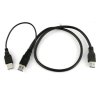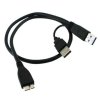OK so I just bought a new car with Android Auto and Apple CarPlay. I like the features that are included and wish to use it all the time. However, the problem is that the USB port that I have to plug the phone into only puts out 500mA or less, just enough to maintain the charge of the phone while it is in use. Would it have killed them to put out 2A?!
Aaaanyway... I was wondering if I could make a frankencable that connects the data wires to the car, and the power wires to my cigarette lighter charger.
For anyone familiar with wiring USB cables, the standard cable does something like this:

What I am proposing is to make a cable that does this:

I do not know if this is possible, if it will work, if it will damage my phone, or if it will cause my car to explode dramatically while on the freeway bringing joy to other drivers.
Are there any people in this forum familiar with USB wiring who can provide me with some feedback as to the possibility of doing something like this, and how hard it would be?
Thanks in advance!
- Naz,
Aaaanyway... I was wondering if I could make a frankencable that connects the data wires to the car, and the power wires to my cigarette lighter charger.
For anyone familiar with wiring USB cables, the standard cable does something like this:
What I am proposing is to make a cable that does this:
I do not know if this is possible, if it will work, if it will damage my phone, or if it will cause my car to explode dramatically while on the freeway bringing joy to other drivers.
Are there any people in this forum familiar with USB wiring who can provide me with some feedback as to the possibility of doing something like this, and how hard it would be?
Thanks in advance!
- Naz,


